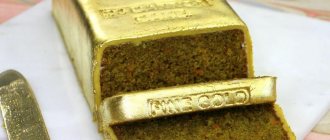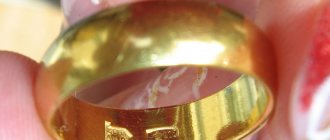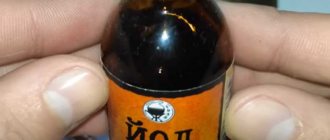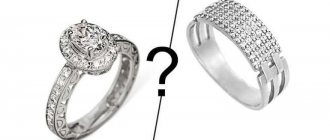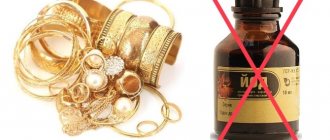What products are being sampled?
According to accepted state standards, all jewelry made of precious metals is subject to testing, regardless of the use of artistic processing or stone inserts. The mark is also placed on anniversary medals or badges, except for state awards.
The sample differs not only in the combination of numbers, but also in its shape. So, for silver jewelry it is an oval, with cuts on both sides; for platinum jewelry - an octagon stretched horizontally; for gold – two combined rectangles, called a “spatula”.
Gold markings - what do the numbers mean?
The hallmarking process is regulated by the state assay supervision authority, located within the Ministry of Finance. All gold items, including those imported from abroad, are subject to testing, analysis and stamping.
- What do the sample numbers mean? They correspond to the following percentage designations: 375 standard demonstrates a gold content of 37.5%; 500 – 50%; 585 – 58.5%; 750 implies 75% gold inclusion; and the highest standard - 999 indicates a precious metal content of 99.9%.
- Due to the fact that gold is very soft, other metals are added to the alloy for practicality: silver, copper, palladium, nickel, platinum.
- The composition of the alloy has a direct impact on the color of the products: white, pink, yellow-green, yellowish and deep yellow.
Products without sample
Sometimes metals are not tested. Such cases include:
- Gold leaf, gold or silver notches on religious objects, cutlery, home decor elements (vases, boxes).
- Nuggets that are used for decoration (for them it is enough to have a confirming certificate).
Also, the stamp is not placed on metals imported into the country if the amount of gold or silver in them reaches even the lowest standard threshold.
Stamping and types and features of branding
What does the sample look like after branding?
Admiring the precious shine of a gold ring, bracelet or earrings, and seeing a neat digital designation on them, we ask ourselves: how is the hallmark set? Let's look at three types of sample application and the equipment used for this.
1. Mechanical method - is a classic option for marking gold. Applying an imprint using a percussion tool - a stamp with a relief digital image of the mark on the end.
2. Electric spark application - making impressions with a pulse discharge from copper electrodes under the influence of electric current. An electric machine burns the print using a pulsed spark in the presence of an aqueous medium.
3. Laser proof - the mark is applied to precious jewelry that has a convex or concave shape. Laser branding produces the finest engraving, almost invisible to the naked eye.
The quality of the jewelry and the authenticity of the sample are confirmed by a document (certificate/tag), which indicates the quantitative characteristics of the alloy and technical requirements.
How precious metals are assayed
The hallmark mark on gold, silver or platinum products is placed according to established regulations and is strictly controlled by the state. Assay supervision controls each manufactured product to ensure compliance with its stated requirements. The sample is taken using laser or electric spark equipment by supervisory inspection staff.
What samples are used for drag. metals
Since 1927, the country has used the metric system for testing. Thus, a 585-karat gold ring differs from a 750-karat gold ring in that the percentage of pure metal in the second product exceeds the first.
- For gold, 500, 375, 999 and 958 samples are also used.
- Silver is hallmarked with hallmarks of 800, 830, 925 and 960.
- For platinum, the hallmarks used are 900, 950 and 990.
But in other countries, the karate testing system is common. Its roots go far into the past. According to the system, the pure gold content of an item is determined by how many carats are contained in the Cologne mark.
- 1 carat is equal to 9.7 g, and the Cologne mark is 233.8 g.
- For pure gold, a 24 karat hallmark is used.
- An 18 carat hallmark indicates that the product contains 6 carats of impurities.
What is the difference between gold and gilding
Gilding - metal coated with a layer
gold. Different countries have certain requirements for the manufacture of gold-plated products.
On the market you can often find gold-plated jewelry, which is based on silver or an alloy of metals.
The concept of medical gold appeared thanks to marketing tricks. The alloy can be coated with a thin layer of gold, and sometimes can be made without it. The medical alloy is hypoallergenic and durable. Additional coating only decorates the product.
How to read a sample on jewelry
In addition to the digital hallmark, jewelry is marked with an alphabetic code called a name tag. As a rule, it consists of four letters of the alphabet and has a simple decoding. The first letter indicates the year the jewelry was made. Since the system was adopted in 2001, the letter A is 2001, B is 2002, C is 2003, and so on. The second letter indicates the punch inspection body that carried out the inspection of the product. The third and fourth letters are the manufacturer's code. Their combination is not repeated within the work area of one inspection. If there is a letter P next to the nameplate, this indicates restoration of the decoration.
How to distinguish gold from fake
The determination of real precious material must be carried out in combination.
- Visual inspection. The product must be marked with a sample or its carat weight. The markings can be easily viewed through a magnifying glass or by taking a photo on a smartphone in macro mode.
- Barcode verification. There are online programs that clearly explain how to check the authenticity of a product. Product tags contain a barcode that can be scanned in the application or entered the code using a special website.
Next, we will consider several ways that will distinguish a fake from the original.
Where is the sample placed?
For each product, the location of the sample is different. On rings it can be placed both outside and inside the rim. On earrings, the hallmark is placed on the pin and earring. Pendant jewelry is branded on the hanging ring, and bracelets are branded on the last link at the lock. Wherever the sample is placed, every master strives to make it small and invisible, so it is better to use a magnifying glass to study the inscription.
In our jewelry workshop you can order jewelry of 585 and 750 gold in red, yellow and white. To do this, fill out an application on our website or call the number provided.
Hallmarks on jewelry
When choosing jewelry made of precious metal, to purchase a fake product that is not made of gold and silver - what could be more offensive? In addition to disappointment, buying a “jewel” skillfully disguised as jewelry with a really high cost will result in a loss of money. How to avoid being scammed?
The most reliable way to control the authenticity of jewelry in Russia is to check the presence of two marks on it: the imprint of the state assay office and the “name” of the manufacturer.
What is a hallmark?
The State Assay Office stamp, often also referred to as a hallmark, is a mark that is placed on gold and silver jewelry. The presence of such a mark on the product indicates that the ring, earrings or pendant are legally sold in Russia - the sale of products made of precious metals that do not have an imprint is prohibited in the Russian Federation.
The stamp of the state assay office consists of several parts. The general outline contains the elements of the print: the head of a girl in a kokoshnik, looking to the right, the code of the state inspection of assay supervision, located at the bottom left of the image, a digital code indicating the quantitative content of pure gold in the jewelry alloy. The code of the State Assay Supervision Inspectorate allows you to find out where the jewelry was tested.
The general outline in which the parts of the mark are enclosed should be different depending on what precious metal the product is made of. Thus, the mark of gold products is outlined with a contour reminiscent of a spatula, of silver - an oval cut off on the right and left, and of platinum - an octagon elongated horizontally.
If among old jewelry you find a product with a stamp on which a star is depicted, do not be alarmed - such stamps were used to mark products made of precious metal in Soviet times. The shape of the contour for types of metal in Russia has remained unchanged.
On complex jewelry that is not directly connected to each other, another, additional mark is placed. It is a digital code for the content of pure precious metal and is applied, for example, to studs - after all, the lock parts of this type of earrings are detachable.
What is a “name”?
“Manufacturer’s name” is the second mark, the presence of which is necessary on a piece of jewelry. It is a kind of analogue of a label on clothing and contains information about the manufacturer. By deciphering the print, you can get the most complete information about the purchased jewelry.
The “name” stamp is a four-digit alphabetic code enclosed in a single outline. It is rectangular in shape and, as a rule, is applied next to the “test”.
The print contains four letters. The first will indicate the year when the product was produced (for example, “N” - 2012, “O” - 2013, “P” - 2014). The second will indicate the code of the Russian state assay inspection body where the product was tested (for example, “B” - Verkhne-Volzhskaya). The last two letters are the manufacturer’s individual code, which cannot be repeated within the same inspection.
Using the manufacturer's stamp, in case of doubt about the jewelry, you can find out when, where and by whom the jewelry you purchased was produced.
Where to look for stamps?
To ensure the authenticity of a piece of jewelry before purchasing it in a store, it is important to check for the presence of stamps on it. You should arm yourself with a magnifying glass: to maintain an aesthetic appearance, they are made small, and the information on them can only be discerned with a magnifying tool.
For different types of products, imprints are applied in different places. So, on the rings you need to look for them on the inside or outside of the tire. On earrings, the mark is most often placed on a pin or earring. On pendants, marks are placed on the hanging rings. If you are purchasing a bracelet, you should look for the imprint on the ring or link connecting the main part of the product and the lock. Manufacturers strive to apply brands so that their presence does not affect the appearance of the jewelry.
Depending on the technology, prints can be of different types. The most common - embossed - is not always possible to use for particularly delicate jewelry. In this case, a spark print is applied, in which even the most minimal deformation can be avoided.
Do your jewelry have all the necessary hallmarks?
Why don't they make jewelry out of pure gold?
As you already know from the previous material, gold is a very soft metal. Pure gold jewelry will not be durable and will quickly lose its shape. Literally in a matter of days. In addition, the metal is susceptible to corrosion and discoloration. You won't like any of these factors, so professional jewelers make jewelry from alloys of gold with other metals and additives, which are called alloys. The additive can be copper, tin, nickel and even precious palladium.
Pure gold is stored only in the form of bars.
Is it possible to sell?
The price of the yellow metal is constantly increasing, so buying it for resale or recycling has become a popular phenomenon. But some products are without quality marks. Jewelry without markings can be sold. To do this, you need to go to a pawnshop. It will set the price of the product, but it will be significantly lower, because such institutions purchase gold as scrap precious metal.
If there are gold items with unclearly visible numbers (if the item is old, they may have been partially erased), melted down or made by private jewelers, if necessary, they can be pledged or purchased as a product or precious metal. There is no need to worry about whether the pawnshop will accept gold without hallmarks. The answer is clear - he will accept it, but at a reduced cost.
The pawnshop has no right to continue selling jewelry without the markings. For assaying before sale, all goods must be submitted to the Assay Office for installation of quality marks on them.
Why is 585 sample so popular?
The 585 alloy is considered literally the golden mean in the world of jewelry. There are several reasons for this:
- Nice appearance
- Ideal hardness
- Right price
- Wear resistance
Please note: 14k gold items look especially good. They are not dull and at the same time do not vulgarly attract attention with their brightness.
Why is it missing?
Markings on gold jewelry are not always present. The absence is due to various reasons.
- In cases where a chain, bracelet or ring without hallmarking is a family heirloom, has been inherited and belongs to a time when hallmarking of jewelry did not exist.
- If the jewelry is made privately to order.
- After restoration, a fragment remains, a small piece, since the master tries to leave a sample on the product itself, and also if the earring lock, chain was repaired, or the ring size was changed.
- Another reason why there is no hallmark on a gold ring is re-melting.
- The purchase of jewelry was carried out abroad. But in such cases there must be a mark on it.
- When gold is used for medical purposes (dental crowns), it is not assayed. It is of high quality and durable, it is difficult to deform.
In all cases where the precious item was without hallmark, it will be valued as scrap gold, but if the appearance is quite good, the merchandiser can evaluate it at his discretion.
